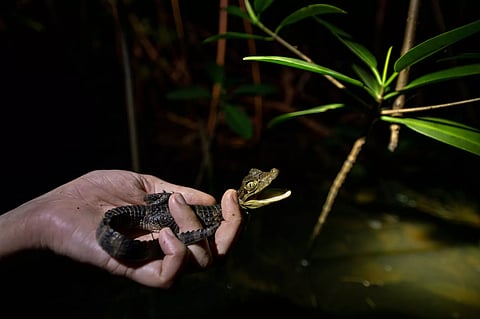

By Freda Kreier
NEW YORK: Sidney Godfrey was sitting in the passenger seat of a truck slowly cruising over a levee one night in 2018. This far into Florida’s dry season, the air was thick with the smell of mud wafting up from the exposed canals and wetlands along the edge of Biscayne Bay, south of Miami. Godfrey, a wildlife biologist, kept his gaze — and his headlamp — pointed down to light up the water at the base of the levee. The glint of a reptilian eye came from a grove of Australian pine below. The hunt was underway.
It was Godfrey’s first night surveying with the Croc Docs — the nickname for a University of Florida lab based out of Fort Lauderdale. He and Ed Metzger, that evening’s survey leader, stepped out of the truck and started making their way down to the target. They soon found themselves wading through muck. Their legs punched through layers of pine needles mixed with mud. Each step dredged up the smell of dead and decaying things. The owner of the shining eyes had spotted the pair and was doing his best to move away from the lumbering humans. But the researchers persisted, slowly, painfully, wading toward an animal that was neither a trademark Florida gator nor a native crocodile. Their quarry was instead a six-foot-long spectacled caiman.
The caimans of southern Florida are not as well known as their alligator cousins. Half a century ago, caimans were taken from their homelands in tropical wetlands of Latin America and brought to the United States for the leather and pet trades. Most of the hundreds of thousands of caimans imported into the United States during the 1970s perished. But a few held out in the southernmost corner of the Sunshine State. Like many invasive species in Florida, they’ve become a nuisance.
Scientific understanding of the effects of invasive caimans is still evolving. But researchers have spotted signs that caimans might crowd out American alligators and American crocodiles, while preying on vulnerable indigenous species. And the animals are more aggressive when cornered than native crocodilians, potentially putting people at risk of attacks.
Over the last decade, the Croc Docs have run surveys across Miami-Dade County in an attempt to understand the lives of these elusive predators. This isn’t idle curiosity. By learning about caimans, the lab has been working to bring their numbers under control. It’s a goal shared with state and federal agencies, including the U.S. Fish and Wildlife Service.
And it’s a goal that may be attainable. The crew has spotted fewer and fewer caimans along survey routes in recent years. In a study published this August, the researchers found that the area’s caiman populations might be on the decline. If so, the caiman could become one of the few invasive species that Florida manages to get rid of, or at least get under control.
Godfrey has had that possibility in mind ever since that first night in 2018. After chasing the caiman through the brush, Metzger was able to wrangle a snare around its snout. When the beast tired itself out, the two men made the return journey back to the truck, caiman in tow. The rush of the capture “kind of got me hooked,” Godfrey recalled. It was a life-altering moment. Two months later, he was head surveyor for the caiman project.